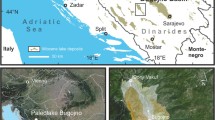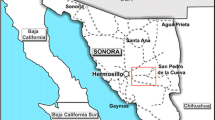Abstract
Microhermal nodules very similar to those from the Oxfordian Smackover Formation are volumetrically important constituents of the Novillo Formation exposed in eastern Central Mexico. The nodules occur within a micritic limestone succession (Novillo Limestone). Coalescence of adjacent nodules leads to a delicate self-supported frame. Microhermal nodules consist of both microbial carbonate and clustered digitate and branching chambered microfossils. The latter occur in the form of crust-like agglomerations or bushy growth habit in small growth-framework cavities created by accretionary microbialites. Main growth patterns are branching upward, downward facing and pendant. Like Renalcis, the microfossils apparently resulted from the activity of calcimicrobes. Terebella, encrusting foraminifers, and Tubiphytes form part of the microhermal biota and occur as subordinate faunal components. The association developed on the floor of a calm, shallow-marine lagoon with restricted water interchange and reduced oxygenation at the sediment–water interface.






Similar content being viewed by others
References
Adatte T, Michalzik D, Lopez-Oliva JG, Stinnesbeck W (2000) Field guide-book Upper Jurassic and Lower Cretaceous of the Monterrey-Saltillo area Soc Mex Pal, 66 pp
Barattolo F (1991) Mesozoic and Cenozoic marine benthic calcareous algae with particular regard to Mesozoic. In: Riding R (ed) Calcareous algae and stromatolites. Springer, Berlin Heidelberg New York, pp 504–540
Baria LR, Stoudt DL, Harris PM, Crevello PD (1982) Upper Jurassic reefs of Smackover Formation, United States Gulf Coast. AAPG Bull 66:1449–1482
Bracken B (1984) Environments of deposition and early diagenesis, La Joya Formation, Huizachal Group red beds, northeastern Mexico. In: Ventress WPS, Bebout DG, Perkins BF, Moore CH (eds) The Jurassic of the Gulf Rim. Gulf Coast Sect Econ Paleontol Mineral Found, Proc 3rd Ann Res Conf 1982, pp 19–26
Carras N (1995) La piattaforma carbonatica del Parnasso durante il Giurassico superiore–Cretaceo inferiore: stratigrafia ed evoluzione paleogeografica. PhD Thesis, University of Athens, Greece, 232 pp
Carrillo-Bravo J (1961) Geología del Anticlinorio Huizachal-Peregrina al NW de Ciudad Victoria, Tamps. Bol Assoc Mex Geol Petrol 13:1–98
Chafetz HS, Guidry SA (1999) Bacterial shrubs, crystal shrubs, and ray-crystal shrubs: bacterial vs. abiotic precipitation. Sediment Geol 126:57–74
De Castro P (1969) Su alcune tallofite del Mesozoico in campania: stratigrafia e paleontologia. Boll Soc Nat Napoli 78:87–167
De Cserna Z (1989) An outline of the geology of Mexico. In: Bally AW, Palmer AR (eds) The Geology of North America: an overview, vol A, Geological Society of America, Boulder, CO, pp 233–264
Dromart G, Gaillard C, Jansa LF (1994) Deep-marine microbial structures in the Upper Jurassic of Western Tethys. In: Bertrand-Sarfati J, Monty C (eds) Phanerozoic stromatolites II, Kluwer, Dordrecht, pp 295–318
Fastovsky DE, Clark JM, Strater NH, Montellano M, Herznandez RR, Hopson JA (1995) Depositional environments of a Middle Jurassic terrestrial vertebrate assemblage, Huizachal Canyon, Mexico. J Vertebr Paleontol 15:561–575
Fels A (1997) Microprolites from ferruginous limestones of the Subbetic Jurassic of southern Spain. In: Schweigert G, Seegis DB, Fels A, Leinfelder RR (eds) New internally structured decapod microprolites from Germany (Late Triassic/Early Miocene), southern Spain (Early/Middle Jurassic) and Portugal (Late Jurassic): taxonomy, palaeoecology and evolutionary implications. Paläont Z 71:61–63
Goldhammer RK (1999) Mesozoic sequence stratigraphy and paleogeographic evolution of northeast Mexico. Geol Soc Am Spec Pap 340:1–58
Götte M (1990) Halotektonische Deformationsprozesse in Sulfatgesteinen der Minas Viejas-Formation (Ober-Jura) in der Sierra Madre Oriental, Nordost-Mexiko. PhD Thesis, TU Darmstadt, Germany, 270 pp
Götte M, Michalzik D (1992) Stratigraphic relations and facies sequences of an Upper Jurassic evaporitic ramp in the Sierra Madre Oriental (Mexico). Zbl Geol Paläont Teil I 1991:1445–1466
Heim A (1940) The front ranges of the Sierra Madre Oriental, Mexico, from Ciudad Victoria to Tamanzunchale. Eclog Geol Helv 33:313–352
Henssel K, Schmid DU, Leinfelder R (2002) Computergestützte 3D-Rekonstruktion in der Paläontologie anhand von Serienschnitten. Math Geol 6:131–142
Heydari E, Wade WJ, Anderson LC (1997) Depositional environments, organic carbon accumulation, and solar-forcing cyclicity in Smackover Formation lime mudstones, northern Gulf Coast. AAPG Bull 81:760–774
Kopaska-Merkel DC (1994) Oncoids to reefs: rolling stones come to rest in the Smackover Formation, Alabahma. Trans Gulf Coast Assoc Geol Soc 44:347–353
Kopaska-Merkel DC, Schmid DU (1999) New (?) bioherm-building tubular organisms in Jurassic Smackover Formation, Alabama. Trans Gulf Coast Assoc Geol Soc 49:300–309
Lehrmann DJ, Wang Y, Wei J, Yu YY, Xiao J (2001) Lower Triassic peritidal cyclic limestone: an example of anachronistic carbonate facies from the Great Bank of Guizhou, Nanpanjiang Basin, Guizhou province, south China. Palaeogeogr Palaeoclimatol Palaeoecol 173:103–123
Leinfelder R, Schmid DU, Nose M, Werner W (2002) Jurassic reef patterns: the expression of a changing globe. SEPM Spec Publ 72:465–520
Luperto Sinni E (1979) Cretacicladus minervini n. gen. n. sp., nuova alga (Chlorophyta) del Cenomaniano della Murge. Atti Ist Geol Paleont Univ Bari 8:1–30
Mancini EA, Benson DJ, Hart BS, Balch RS, Parcell WC, Panetta BJ (2000) Appleton field case study (eastern Gulf Coastal Plain): field development model for Upper Jurassic microbial reef reservoir associated with paleotopographic basement structures. AAPG Bull 84:1699–1717
Mancini EA, Llinas JC, Parcell WC, Aurell M, Badenas B, Leinfelder RR, Benson DJ (2004) Upper Jurassic thrombolite reservoir play, northeastern Gulf of Mexico. AAPG Bull 88:1573–1602
Michalzik D (1988) Trias bis tiefste Unter-Kreide der nordöstlichen Sierra Madre Oriental, Mexiko: fazielle Entwicklung eines passiven Kontinentalrandes. PhD Thesis, TU Darmstadt, Germany, 247 pp
Michalzik D (1991) Facies sequence of Triassic–Jurassic red beds in the Sierra Madre Oriental (NE Mexico) and its relation to the early opening of the Gulf of Mexico. Sediment Geol 71:243–259
Mixon RB, Murray GE, Diaz TG (1959) Age and correlation of Huizachal Group (Mesozoic), State of Tamaulipas, Mexico. AAPG Bull 43:757–771
Olivier N, Pittet B, Mattioli E (2004) Palaeoenvironmental control on sponge-microbialite reefs and contemporaneous deep-shelf marl-limestone deposition (Late Oxfordian, southern Germany). Paleogeogr Palaeoclimatol Palaeoecol 212:233-263
Pawellek T (2001) Fazies-, Sequenz- und Gamma-Ray-Analyse im Höheren Malm der Schwäbischen Alb (SW-Deutschland). Tüb Geowiss Arbeiten 61:1–246
Pawellek T, Aigner T (2003) Stratigraphic architecture and gamma ray logs of deeper ramp carbonates (Upper Jurassic, SW Germany). Sediment Geol 159:203–240
Pratt BR (1984) Epiphyton and Renalcis: diagenetic microfossils from calcification of coccoid blue-green algae. J Sediment Petrol 54:948–971
Salvador A (1987) Late Triassic–Jurassic paleogeography and origin of Gulf of Mexico basin. AAPG Bull 71:419–451
Salvador A (1991) Triassic–Jurassic. In: Salvador A (ed) The geology of North America: the Gulf of Mexico Basin, Vol J, Geological Society of America, Boulder, CO, pp 131–180
Schmid DU (1996) Marine Mikrobolithe und Mikroinkrustierer aus dem Oberjura. Profil 9:101–251
Schmid DU, Henssel K (2001) Die rätselhaften Tubiphyten des Treuchtlinger Marmors. Fr Bay Staatsslg Paläont Hist Geol München. Jb 2000 Mitt 29:45–54
Schmid DU, Leinfelder RR, Nose M (2001) Growth dynamics and ecology of Upper Jurassic mounds, with comparisons to Mid-Palaeozoic mounds. Sediment Geol 145:343–376
Tardy M, Ramirez C, Patino M (1976) El frente de la napa de Parras (conjunto Cadena Alta–Altiplano Central) en el área de Aramberri, N.L., Sierra Madre Oriental, México. Rev Inst Geol UNAM México 2:1–11
Webb GE (2001): Biological induced carbonate precipitation in reefs through time. In: Stanley GD jr (ed) The history and sedimentology of ancient reef systems. Top Geobiol Ser 17:159–203
Winker CD, Buffler RT (1988) Paleogeographic evolution of early deep-water Gulf of Mexico and margins, Jurassic to Middle Cretaceous (Comanchean). AAPG Bull 72:318–346
Wood R (2001) Are reefs and mud mounds really so different? Sediment Geol 145:161–171
Acknowledgments
We thank Felix Schlagintweit (Munich) for his opinion on the similarities between tubular microorganisms and Sgrossoella as well as Cretacicladus. Reinhold Leinfelder (Berlin) provided copies of rare literature. Special thanks to the reviewers Oliver Weidlich (Al-Khod, Sultanate of Oman) and Daniel Kopaska-Merkel (Alabama University, Tuscaloosa, USA) for their valuable comments which helped to improve the paper.
Author information
Authors and Affiliations
Corresponding author
Rights and permissions
About this article
Cite this article
Fischer, R., Michalzik, D. & Helm, C. Microhermal nodules of Renalcis-like calcimicrobes from Oxfordian limestones of the Sierra Madre Oriental (Novillo Formation, Mexico). Facies 53, 239–248 (2007). https://doi.org/10.1007/s10347-006-0099-4
Received:
Accepted:
Published:
Issue Date:
DOI: https://doi.org/10.1007/s10347-006-0099-4




